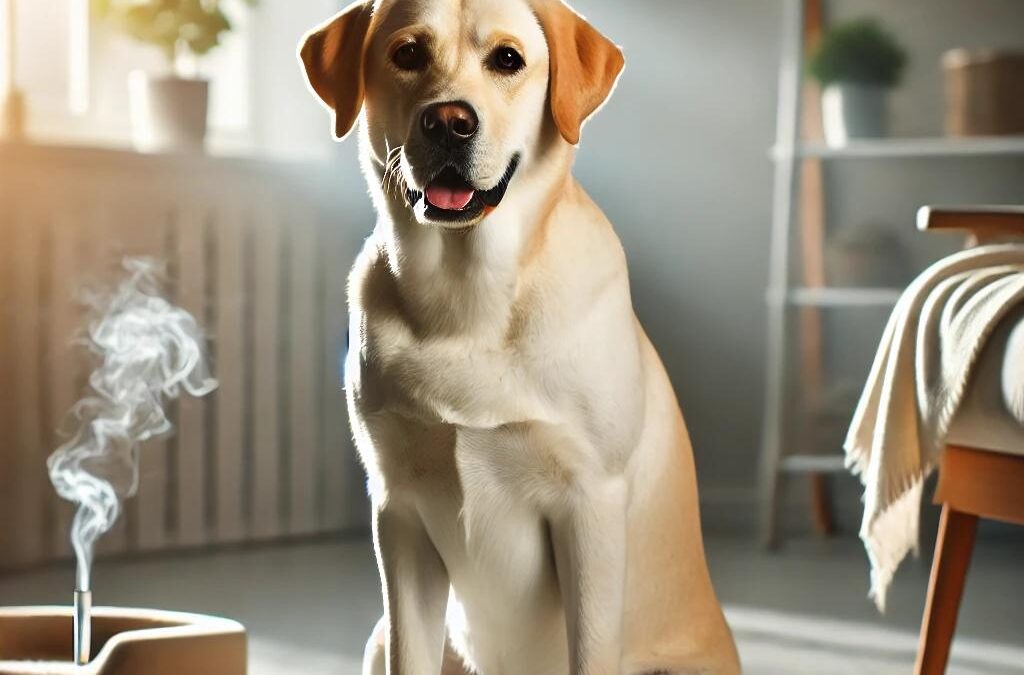Secondhand smoke, long known for its harmful effects on humans, has also been linked to serious health problems in pets, particularly dogs. One of the most concerning health risks for dogs exposed to secondhand smoke is the increased likelihood of developing lung tumors. Although lung cancer is relatively rare in dogs, research suggests that dogs exposed to cigarette smoke may be at a significantly higher risk of developing this type of cancer. In this article, we will explore the dangers of secondhand smoke for dogs, the signs of lung tumors, and steps you can take to protect your pet.
How Secondhand Smoke Affects Dogs
Secondhand smoke consists of the toxic chemicals released from burning cigarettes, cigars, or other tobacco products, as well as the smoke exhaled by the smoker. Dogs that live in households where smoking occurs are exposed to these harmful substances, which can accumulate in their bodies over time.
Just like in humans, exposure to secondhand smoke in dogs can lead to respiratory issues, irritation, and chronic lung conditions. However, the most serious consequence of prolonged exposure is the increased risk of developing lung tumors, particularly in older dogs. These tumors can develop in the lungs, bronchial tubes, or even the nasal passages, depending on the dog’s size and breed.
Why Are Dogs Vulnerable to Secondhand Smoke?
- Sensitive Respiratory Systems
Dogs have sensitive respiratory systems, and their lungs are not equipped to handle prolonged exposure to harmful chemicals like those found in tobacco smoke. Breeds with shorter noses, such as Bulldogs, Pugs, and Boxers, are particularly vulnerable to inhaling toxins because they have less filtration capacity in their nasal passages. - Proximity to Smoke
Dogs often spend time close to their owners, making them more likely to inhale secondhand smoke. Since dogs tend to lie on the floor, they are also exposed to thirdhand smoke, which consists of toxic residues that settle on surfaces such as carpets, furniture, and pet beds. Over time, these chemicals can build up in a dog’s lungs and increase the risk of cancer. - Weaker Immune Systems in Older Dogs
Senior dogs, especially those over the age of 10, have weaker immune systems, which makes them more susceptible to the harmful effects of secondhand smoke. As a dog’s immune system declines with age, their ability to repair damaged cells diminishes, increasing the likelihood of cancerous growths.
The Link Between Secondhand Smoke and Lung Tumors in Dogs
Studies have shown that dogs living in smoking households are at a higher risk of developing lung cancer compared to those living in smoke-free environments. This increased risk is due to the carcinogenic substances found in tobacco smoke, such as nicotine, formaldehyde, and benzene, which can damage lung tissue over time. Inhalation of these toxic substances can cause cellular changes in the lungs, leading to the development of malignant tumors.
Certain dog breeds may be at an even higher risk due to their genetic predisposition to cancer or respiratory sensitivity. For example, long-nosed breeds like Collies and Greyhounds tend to develop nasal cancers more frequently, while shorter-nosed breeds are more likely to develop lung cancers.
Signs of Lung Tumors in Dogs
Detecting lung tumors in dogs can be difficult, as symptoms may not appear until the cancer has progressed. However, some common signs that may indicate lung cancer include:
- Persistent coughing: A chronic cough that does not resolve with treatment may be a sign of lung cancer.
- Difficulty breathing: Labored or rapid breathing can indicate a problem with the lungs.
- Lethargy and fatigue: A noticeable decrease in energy levels may be a sign of illness.
- Weight loss: Unexplained weight loss could indicate a serious health problem.
- Loss of appetite: A lack of interest in food is another potential indicator of lung cancer.
If your dog exhibits any of these symptoms and has been exposed to secondhand smoke, it is crucial to seek veterinary attention. Early detection of lung tumors can significantly improve treatment outcomes.
Diagnosis and Treatment of Lung Cancer in Dogs
When lung cancer is suspected, a veterinarian will perform diagnostic tests such as x-rays or ultrasounds to check for abnormal growths in the lungs. A biopsy may also be performed to determine if the growth is malignant. Once a diagnosis is confirmed, treatment options can include:
- Surgery: If the tumor is localized, surgical removal may be possible. This is often the best treatment option for early-stage lung cancer.
- Chemotherapy and Radiation Therapy: In cases where surgery is not an option or the cancer has spread, chemotherapy and radiation may be used to shrink tumors and slow the progression of the disease.
- Palliative Care: For advanced lung cancer, palliative care may be recommended to manage symptoms and improve the dog’s quality of life.
How to Protect Your Dog from Secondhand Smoke
The best way to protect your dog from the dangers of secondhand smoke is to create a smoke-free environment. Here are a few steps you can take:
- Do not smoke indoors: If you smoke, do so outside and away from your pets to minimize their exposure to harmful chemicals.
- Avoid smoking in enclosed spaces: Never smoke in the car or other confined spaces where your dog may be exposed to concentrated smoke.
- Clean your home regularly: Vacuum carpets and wash your dog’s bedding frequently to remove thirdhand smoke residues from surfaces.
- Quit smoking: The most effective way to protect both your dog and yourself from the harmful effects of smoking is to quit altogether.
Secondhand smoke is a serious health hazard for dogs, increasing their risk of developing lung tumors and other respiratory problems. Pet owners who smoke should be aware of the dangers and take steps to minimize their dog’s exposure to tobacco smoke. By creating a smoke-free environment, you can help protect your dog’s health and reduce the likelihood of lung cancer and other diseases.















